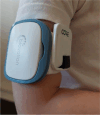Continuous timely monitoring of core temperature with two wearable devices in pediatric patients undergoing chemotherapy for cancer - a comparison study
- PMID: 38400942
- PMCID: PMC10894150
- DOI: 10.1007/s00520-024-08366-w
Continuous timely monitoring of core temperature with two wearable devices in pediatric patients undergoing chemotherapy for cancer - a comparison study
Abstract
Purpose: Pediatric patients with cancer often develop chemotherapy-induced fever in neutropenia (FN), requiring emergency broad-spectrum antibiotics. Continuous temperature monitoring can lead to earlier FN detection and therapy with improved outcomes. We aimed to compare the feasibility of continuous core temperature monitoring with timely data availability between two wearable devices (WDs) in pediatric oncology patients undergoing chemotherapy.
Methods: In this prospective observational two-center study, 20 patients (median age: 8 years) undergoing chemotherapy simultaneously wore two WDs (CORE®, Everion®) for 14 days. The predefined goal was core temperature recorded in sufficient quality and available within ≤ 30 min during ≥ 18/24 h for ≥ 7/14 days in more than 15 patients.
Results: More patients reached the goal with CORE® (n = 13) versus Everion® (n = 3) (difference, 50% p < 0.001). After correcting for the transmission bottleneck caused by two WDs transmitting via one gateway, these numbers increased (n = 15 versus n = 14; difference, 5%; p = 0.69). CORE® measurements corresponded better to ear temperatures (n = 528; mean bias, - 0.07 °C; mean absolute difference, 0.35 °C) than Everion® measurements (n = 532; - 1.06 °C; 1.10 °C). Acceptance rates for the WDs were 95% for CORE® and 89% for Everion®.
Conclusion: The CORE® fulfilled the predefined feasibility criterion (15 of 20 patients) after correction for transmission bottleneck, and the Everion® nearly fulfilled it. Continuous core temperature recording of good quality and with timely data availability was feasible from preschool to adolescent patients undergoing chemotherapy for cancer. These results encourage the design of randomized controlled trials on continuously monitored core temperature in pediatric patients.
Clinicaltrials: gov (NCT04914702) on June 7, 2021.
Keywords: Continuous recording; Fever; Pediatric oncology; Recording vital signs; Supportive care; Temperature measurement; Wearable device.
© 2024. The Author(s).
Conflict of interest statement
JR is meanwhile an employee of Novartis Pharma, Basel, Switzerland. There is no conflict of interest for all other authors.
Figures



Similar articles
-
Vital signs continuously monitored by two wearable devices in pediatric oncology patients, NCT04914702.Sci Data. 2025 May 17;12(1):807. doi: 10.1038/s41597-025-05081-x. Sci Data. 2025. PMID: 40382374 Free PMC article.
-
Continuous recording of vital signs with a wearable device in pediatric patients undergoing chemotherapy for cancer-an operational feasibility study.Support Care Cancer. 2021 Sep;29(9):5283-5292. doi: 10.1007/s00520-021-06099-8. Epub 2021 Mar 3. Support Care Cancer. 2021. PMID: 33655413 Free PMC article.
-
Vital signs in pediatric oncology patients assessed by continuous recording with a wearable device, NCT04134429.Sci Data. 2022 Mar 17;9(1):89. doi: 10.1038/s41597-022-01182-z. Sci Data. 2022. PMID: 35301334 Free PMC article.
-
Current Evidence for Continuous Vital Signs Monitoring by Wearable Wireless Devices in Hospitalized Adults: Systematic Review.J Med Internet Res. 2020 Jun 17;22(6):e18636. doi: 10.2196/18636. J Med Internet Res. 2020. PMID: 32469323 Free PMC article.
-
The Use of Wearables in Clinical Trials During Cancer Treatment: Systematic Review.JMIR Mhealth Uhealth. 2020 Nov 11;8(11):e22006. doi: 10.2196/22006. JMIR Mhealth Uhealth. 2020. PMID: 33174852 Free PMC article.
Cited by
-
Wearable biosensors for pediatric hospitals: a scoping review.Pediatr Res. 2025 Jul;98(1):90-99. doi: 10.1038/s41390-024-03693-4. Epub 2024 Nov 7. Pediatr Res. 2025. PMID: 39511444 Review.
-
Vital signs continuously monitored by two wearable devices in pediatric oncology patients, NCT04914702.Sci Data. 2025 May 17;12(1):807. doi: 10.1038/s41597-025-05081-x. Sci Data. 2025. PMID: 40382374 Free PMC article.
-
Multimodal Noninvasive Assessment of C-Reactive Protein for Systemic Inflammation in Adults: Cross-Sectional Study.JMIR Form Res. 2025 Aug 26;9:e77108. doi: 10.2196/77108. JMIR Form Res. 2025. PMID: 40856619 Free PMC article.
-
Scoping review of the utilization of wearable devices in pediatric and young adult oncology.NPJ Digit Med. 2025 Jul 31;8(1):488. doi: 10.1038/s41746-025-01842-5. NPJ Digit Med. 2025. PMID: 40745222 Free PMC article.
-
Comparison of Wireless Continuous Axillary and Core Temperature Measurement after Major Surgery.Sensors (Basel). 2024 Jul 10;24(14):4469. doi: 10.3390/s24144469. Sensors (Basel). 2024. PMID: 39065867 Free PMC article.
References
-
- Koenig C, Schneider C, Morgan JE, Ammann RA, Sung L, Phillips B. Association of time to antibiotics and clinical outcomes in patients with fever and neutropenia during chemotherapy for cancer: a systematic review. Support Care Cancer. 2020;28(3):1369–1384. doi: 10.1007/s00520-019-04961-4. - DOI - PubMed
-
- Koenig C, Bodmer N, Agyeman PKA, et al (2020) 39.0°C versus 38.5°C ear temperature as fever limit in children with neutropenia undergoing chemotherapy for cancer: a multicentre, cluster-randomised, multiple-crossover, non-inferiority trial. Lancet Child Adolesc Health 4(7):495–502. 10.1016/S2352-4642(20)30092-4 - PubMed
Publication types
MeSH terms
Associated data
LinkOut - more resources
Full Text Sources
Medical
Miscellaneous

